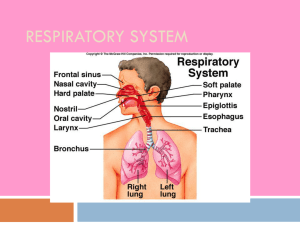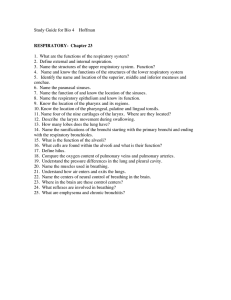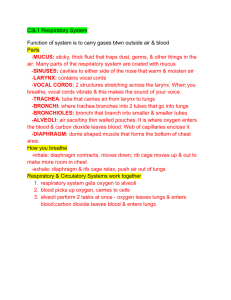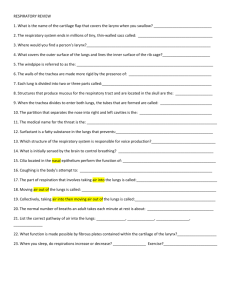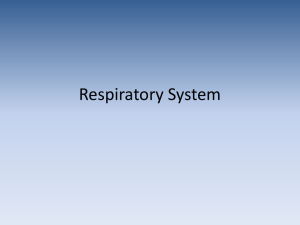The Digestive System- Chapter 15 1
advertisement
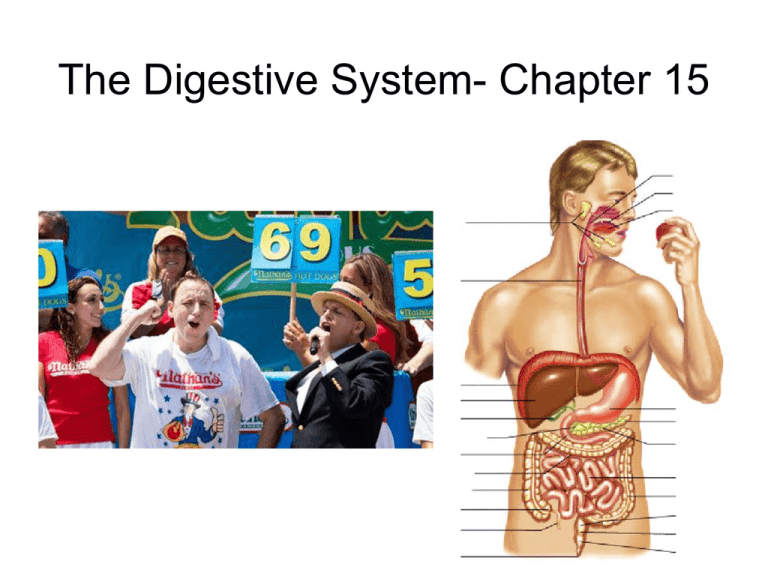
The Digestive System- Chapter 15 1 Functions of the Digestive System • Ingestion- the process of taking foods and liquid into the mouth. • Secretion- the release of water, acid, buffers, and enzymes by cells and accessory organs into the lumen. • Mixing and propulsion- alternating contraction and relaxation of smooth muscle. • Digestion- mechanical and chemical break down of organic material into small molecules. • Absorption- uptake of fluids, small molecules, and ions by epithelial cells lining the lumen. • Defecation- elimination of indigestible substances, bacteria, cells, and digested 2 materials through the anus. The Digestive System • Long hollow tube- the gastrointestinal tract. – Lumen- the hollow region that food, fluids, and waste travels through. • Accessory organs secrete substances into the GI tract (salivary glands, pancreas, liver, gallbladder). 3 The Mouth • Anatomy- entrance to digestive system. • Functions – Determine quality- taste buds. – Mechanical breakdownteeth. – Chemical breakdownenzymes are secreted from the salivary glands. – Formation of a bolus- a soft and round mass of food, formed by the tongue. Labial frenulum Gingivae Hard palate Soft palate Uvula Lingual frenulum 4 Taste Buds- determine quality • Anatomylocated along the sides of papillae. • Function- to determine food quality. E. coli 5 Salivary Glands- chemical breakdown 6 Tongue- bolus formation 7 Pharynx- throat • Anatomy – Muscular tube (5 inches long) that hangs from the skull. • Functions – Acts as a passageway for food and air. – Swallow • Soft palate closes off the nasopharynx, and the larynx moves under the epiglottis to cover the rima glottidus. 8 The Pharynx- throat Nasopharynx Oropharynx Laryngopharynx 9 10 The Esophagus • Anatomy – A collapsible 10 inch long muscular tube. • Functions – Secrete mucus and transport food from the pharynx to the stomach. • Rhythmic waves of muscle contraction (peristalsis). 11 Stomach Anatomy • J-shaped muscular sac with 3 layers of smooth muscle and rugae lining the inner wall. 12 Stomach Histology • Inner lining contains millions of gastric glands. – Gastric juice- HCL and pepsinogen, 3 liters/day. – Mucus- protects the stomach from gastric juice, alkaline in pH. 13 14 Stomach Functions • 3 Major Functions – Storage of food. – Liquefaction of food. – Initiation of protein digestion. • Smooth muscles churn and mix food and gastric juices for 3-5 hours. – Chyme- a soupy mixture of food and gastric juices. 15 Small Intestine • Functions – Chemical digestion – Nutrient absorption • Anatomy – Duodenum (1st 10 inches). • Enzymes • Bile • Sodium Bicarbonate – Jejunum (3 feet). – Ileum (6 feet). 16 Small intestine Greater Omentum- fatty apron. 17 Small Intestine Histology • The inner walls contain circular folds, villi, and microvilli (brush border). 18 Pancreas • Anatomy – Exocrine tissue- produce and secrete digestive juices. • Functions – Enzymes- chemical digestion. 19 Location of the Pancreas 20 Liver Functions • All absorbed nutrients are sent to the liver for processing via the hepatic portal vein. • 500 functions to the liver – Detoxifies blood. – Stores iron and fat-soluble vitamins (A, D, E, K). – Stores glucose as glycogen, breaks down glycogen. – Regulates blood cholesterol. 21 Gallbladder • Anatomy- pear-shaped sac. • Function- stores bile, ~50 ml. • Bile – Yellow-green color. – Components: • Water and cholesterol. • Na and K salts of bile acids. • Bile pigments (bilirubin). 22 Gallstones 23 Large Intestinal Anatomy • Diameter is ~3 inches, length is ~5 feet. • Consists of 4 specialized regions – Cecum (~3 inches long) – Colon • Ascending, transverse, descending, sigmoid. – Rectum – Anus 24 Large Intestine Functions • Absorb water, sodium, and potassium ions from indigestible foods. • Store feces. • Eliminate the feces from the body. • Passes material in 18-24 hours. Note: No enzymes are secreted by the large intestine. 25 Symbiotic Bacteria Reside in the Colon • Numbers- about 50 species. • Fecal component- accounts for 1/3 of the weight of feces. • Nourished by undigested foods. • Metabolic processes produce gas. • Some produce vitamins B and K. • They decompose pigmented molecules, which give feces its brown color. 26 Respiratory System- Chapter 14 27 Functions of the Respiratory System • • • • • Gas exchange Site for sense of smell receptors Filters inspired air Aides in sound production Regulate blood pH 28 Respiratory Structures • Upper respiratory tract • • • • Sinuses Nasal Cavity Pharynx- throat Larynx- voice box • Lower respiratory tract • Trachea- windpipe • Bronchial tree- airways • Lungs 29 The Nose and Sinuses • Anatomy – Nose • Two cavities. – Composed of bone and cartilage. – Sinuses • Four air-filled spaces in the skull. • Functions of the Nasal Cavity – Olfaction; filter, warm and moisten air. • Functions of the Paranasal Sinuses – Lighten skull, resonate voice, warm and moisten air. 30 Sinuses 31 32 The Pharynx- throat Internal nares Nasopharynx Oropharynx Tonsils Laryngopharynx Cricoid cartilage 33 The Larynx- voice box • Passageway for air. – When food is swallowed, the larynx moves against the epiglottis preventing food from passing into it. • The larynx contains the vocal cords, which are stretched across the rima glottidus. 34 Cartilage of the Larynx Epiglottis Thyroid cartilage Adam’s Apple Cricoid cartilage 35 Movement of Vocal Cords • Vocal folds are open during breathing and closed 36 during speech. Trachea- windpipe • Size- 5 inches long and 1 inch in diameter. • Position- anterior to the esophagus. • Tracheal cartilage- 16 to 20 incomplete rings. • Open side faces esophagus. • Mucosa- epithelium with cilia and goblet cells. 37 Trachea Tracheal cartilage Lumen of Esophagus Lumen of Trachea Tracheal Cartilage 38 39 • Each bronchiole leads to an elongated space (lobule) that is enclosed by alveoli. • Alveoli- surfaces for gas exchange, 300 million in each lung, surface area of a tennis court. – A thin-walled, round chamber, surrounded by a vast network of capillaries. – Gases diffuse from alveoli into blood in the capillaries. 40 • Inspiration Inhalation, air is conducted toward the lungs. • Expiration Exhalation, air is conducted away from the lungs. 41 Inspiration Versus Expiration 42 43 44 The Lungs • Position- lie on both sides of the heart within the thoracic cavity; lined by pleura. – Right lung has 3 lobes – Left lung has 2 lobes • Each lobe is divided into lobules. 45 2 Circuits of Gas Exchange • Pulmonary Circuit- circulates blood through the lungs. • Systemic Circuit- circulates blood through the rest of the body. 46 Respiration and Health • Upper Respiratory Tract Infections – Sinusitus- infection of the cranial sinuses. – Tonsillitis- inflammation and enlargement of tonsils. – Rhinitis- chronic or acute inflammation of the mucus membrane of the nose. – Laryngitis- infection of larynx with hoarseness and inability to talk. • Lower Respiratory Tract Infections – Bronchitis- infection of primary and secondary bronchi. – Pneumonia- acute viral or bacterial infection or inflammation of the alveoli. – Tuberculosis (TB)- a highly variable and infectious communicable disease caused by a bacterium that damages the lungs and the pleurae. 47 Smoking and Disease • Smoking- leading cause of death in the U.S. • One cigarette- 5-7 minutes off your life, 10 years total on average. • Smoke- 4,000 substances. – 3 radioactive substances. – 50 carcinogens. – Poisons- hydrogen cyanide, carbon monoxide, and cresols. 48


